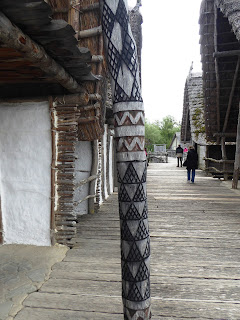Very wet weather encouraged us to stop at La Gruyère services where we bought cheese and admired painted cows: apparently these were done by Geneva school children some years ago as a competition and then auctioned off for charity. We particularly liked "cowpride".
By the time we drew up in the car park on the south side of the waterfalls the rain hadn't abated but we waited for a lull before getting our tickets and walking through the castle to the view points. These involve around 150 steps down (and up again) but luckily it stayed dry for long enough though it wasn't conducive to the short walk (up one side and back down the other) we had planned :(
 |
| The little tourist boats land people on the rock in the middle of the falls where they can climb up to the top |
The Riss age river and falls followed a more northerly course, entering the river below the present day falls, more or less where the green, grassy slope is on the far bank.
Both falls cut through an outcrop of Upper Malm age carbonate rock.
 |
| Water |
After a night in a peaceful, rural farmhouse, on Sunday morning we went to the Stilt House museum on the Bodensee.
 |
| Add caption |
I've been fascinated by prehistoric lake villages since I learned about them at school and this was a great opportunity to see one where houses from various periods - palaeolithic through to bronze age - had been reconstructed following underwater excavations over the last hundred years.
 |
| Dugout canoe |
 |
| The roof beams and purlins are lashed together |
A series of video presentations showed the process of finding the piles the houses had been built on, before delivering us to a German speaking guide who showed us where to go. The reconstructions are built out over the lake and a number of them have workshops of various types which gives some idea of the life in those times.
 |
| Add caption |

Fragments found of painted posts were the model for this one
 |
| Explanation of the reconstruction method |
An afternoon on the Danube
On Saturday we had seen the Rhône, which ultimately ends up in the Mediterranean, flowing into Lake Geneva through the Petit Camargue delta, and then the Rhine, roaring over Schaffhausen falls on its way to the North Sea, so the temptation to complete a triple in two days was too much to resist and after lunch we head north to the Danube valley where the river flows east from the Black Forest on its way, ultimately, to the Black Sea.
The road took us through pretty villages of fachwerkhäuser, churches with crow stepped gables topping the towers, and numerous May Bushes.
The half-timbered houses aren't done in the traditional English "black and white" style but come in all colours which I find particularly attractive.
Stepped gables are reminiscent of Scotland to my British eyes but are apparently quite common on the European mainland.

The May Bushes are a feature of every village, indeed I saw three in one place! Apparently they are put up on 1 May and there's a tradition of trying to steal trees from neighbouring villages so perhaps the multiple ones I saw had been nicked from elsewhere!

 They are an actual pine tree, stripped of bark and branches apart from the topknot left on and then decorated with garlands - at least one - and sometimes fir spirals and plentiful coloured streamers.
They are an actual pine tree, stripped of bark and branches apart from the topknot left on and then decorated with garlands - at least one - and sometimes fir spirals and plentiful coloured streamers.Some have metal plaques jutting out from the sides depicting local trades.
https://www.thelocal.de/20190430/germanys-most-bizarre-may-1st-celebrations-may-day-maypole
 |
| A tunnel gave good access to look at the limestone |
Driving on down a wooded ravine was very like Burrington Combe in the Mendips, and judging by the parked cars and signs, just as popular with climbers.
 |
| The wooded limestone gorge leading down to the Danube |
 |
| Jurassic limestone crags in the wooded sides of the Danube Valley |
 |
| A castle perched high above the river - Schloẞ Werenwag? |

There are fachwerkhäuser here too - a less prettied up example...
 And we found a cute fountain with a couple of gnome-like firemen!
And we found a cute fountain with a couple of gnome-like firemen! |
| The schloß looks closed up |
Sadly the local schloẞ seems unused - here it is in better days

Our apartment, on the ground floor of a farmhouse, was beautifully peaceful - good preparation for a busy time ahead!









No comments:
Post a Comment